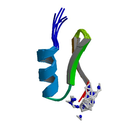
Scyllatoxin (T3D2523)
| Record Information | |||||||||||
|---|---|---|---|---|---|---|---|---|---|---|---|
| Version | 2.0 | ||||||||||
| Creation Date | 2009-07-03 22:19:10 UTC | ||||||||||
| Update Date | 2014-12-24 20:25:39 UTC | ||||||||||
| Accession Number | T3D2523 | ||||||||||
| Identification | |||||||||||
| Common Name | Scyllatoxin | ||||||||||
| Class | Protein | ||||||||||
| Description | Scyllatoxin is a peptide toxin produced by the Yellow scorpion (Leiurus quinquestriatus hebraeus). It blocks small conductance calcium-activated potassium channels. (4) | ||||||||||
| Compound Type |
| ||||||||||
| Protein Structure |  | ||||||||||
| Synonyms |
| ||||||||||
| Chemical Formula | Not Available | ||||||||||
| Average Molecular Mass | 3430.130 g/mol | ||||||||||
| CAS Registry Number | 142948-19-4 | ||||||||||
| Sequence | Not Available | ||||||||||
| Chemical Taxonomy | |||||||||||
| Description | Not Available | ||||||||||
| Kingdom | Organic Compounds | ||||||||||
| Super Class | Organic Acids | ||||||||||
| Class | Carboxylic Acids and Derivatives | ||||||||||
| Sub Class | Amino Acids, Peptides, and Analogues | ||||||||||
| Direct Parent | Peptides | ||||||||||
| Alternative Parents | Not Available | ||||||||||
| Substituents | Not Available | ||||||||||
| Molecular Framework | Not Available | ||||||||||
| External Descriptors | Not Available | ||||||||||
| Biological Properties | |||||||||||
| Status | Detected and Not Quantified | ||||||||||
| Origin | Exogenous | ||||||||||
| Cellular Locations |
| ||||||||||
| Biofluid Locations | Not Available | ||||||||||
| Tissue Locations | Not Available | ||||||||||
| Pathways | Not Available | ||||||||||
| Applications | Not Available | ||||||||||
| Biological Roles | Not Available | ||||||||||
| Chemical Roles | Not Available | ||||||||||
| Physical Properties | |||||||||||
| State | Liquid | ||||||||||
| Appearance | Clear solution. | ||||||||||
| Experimental Properties |
| ||||||||||
| Predicted Properties | Not Available | ||||||||||
| Spectra | |||||||||||
| Spectra |
| ||||||||||
| Toxicity Profile | |||||||||||
| Route of Exposure | Injection (sting/bite) (5) | ||||||||||
| Mechanism of Toxicity | Scyllatoxin blocks small conductance calcium-activated potassium channels. This inhibits the slow after-hyperpolarisation that follows an action potential in some nerve cells.(4) | ||||||||||
| Metabolism | Free toxin may be removed by opsonization via the reticuloendothelial system (primarily the liver and kidneys) or it may be degraded through cellular internalization via the lysosomes. Lysosomes are membrane-enclosed organelles that contain an array of digestive enzymes, including several proteases. | ||||||||||
| Toxicity Values | LD50: 0.25 mg/kg (Subcutaneous, Mouse) (1) | ||||||||||
| Lethal Dose | Not Available | ||||||||||
| Carcinogenicity (IARC Classification) | No indication of carcinogenicity to humans (not listed by IARC). | ||||||||||
| Uses/Sources | Scyllatoxin is a peptide toxin produced by the Yellow scorpion (Leiurus quinquestriatus hebraeus). (4) | ||||||||||
| Minimum Risk Level | Not Available | ||||||||||
| Health Effects | Stings from the Yellow scorpion are painful but not usually fatal. However, in some cases envenomation may cause anaphylaxis, a potentially life-threatening allergic reaction to the venom. (2) | ||||||||||
| Symptoms | Stings from the Yellow scorpion are painful but not usually fatal. (2) | ||||||||||
| Treatment | An antivenom exists for Leiurus quinquestriatus stings. (3) | ||||||||||
| Normal Concentrations | |||||||||||
| Not Available | |||||||||||
| Abnormal Concentrations | |||||||||||
| Not Available | |||||||||||
| External Links | |||||||||||
| DrugBank ID | Not Available | ||||||||||
| HMDB ID | Not Available | ||||||||||
| PubChem Compound ID | 71311759 | ||||||||||
| ChEMBL ID | Not Available | ||||||||||
| ChemSpider ID | Not Available | ||||||||||
| KEGG ID | Not Available | ||||||||||
| UniProt ID | P16341 | ||||||||||
| OMIM ID | |||||||||||
| ChEBI ID | Not Available | ||||||||||
| BioCyc ID | Not Available | ||||||||||
| CTD ID | Not Available | ||||||||||
| Stitch ID | Scyllatoxin | ||||||||||
| PDB ID | 1SCY | ||||||||||
| ACToR ID | Not Available | ||||||||||
| Wikipedia Link | Not Available | ||||||||||
| References | |||||||||||
| Synthesis Reference | Not Available | ||||||||||
| MSDS | Not Available | ||||||||||
| General References |
| ||||||||||
| Gene Regulation | |||||||||||
| Up-Regulated Genes | Not Available | ||||||||||
| Down-Regulated Genes | Not Available | ||||||||||
Targets
- General Function:
- Small conductance calcium-activated potassium channel activity
- Specific Function:
- Forms a voltage-independent potassium channel activated by intracellular calcium. Activation is followed by membrane hyperpolarization. Thought to regulate neuronal excitability by contributing to the slow component of synaptic afterhyperpolarization. The channel is blocked by apamin (By similarity).
- Gene Name:
- KCNN1
- Uniprot ID:
- Q92952
- Molecular Weight:
- 59986.87 Da
References
- Wikipedia. Scyllatoxin. Last Updated 5 April 2009. [Link]
- General Function:
- Small conductance calcium-activated potassium channel activity
- Specific Function:
- Forms a voltage-independent potassium channel activated by intracellular calcium. Activation is followed by membrane hyperpolarization. Thought to regulate neuronal excitability by contributing to the slow component of synaptic afterhyperpolarization. The channel is blocked by apamin.
- Gene Name:
- KCNN2
- Uniprot ID:
- Q9H2S1
- Molecular Weight:
- 63759.03 Da
References
- Wikipedia. Scyllatoxin. Last Updated 5 April 2009. [Link]
- General Function:
- Small conductance calcium-activated potassium channel activity
- Specific Function:
- Forms a voltage-independent potassium channel activated by intracellular calcium. Activation is followed by membrane hyperpolarization. Thought to regulate neuronal excitability by contributing to the slow component of synaptic afterhyperpolarization. The channel is blocked by apamin.
- Gene Name:
- KCNN3
- Uniprot ID:
- Q9UGI6
- Molecular Weight:
- 82025.305 Da
References
- Wikipedia. Scyllatoxin. Last Updated 5 April 2009. [Link]